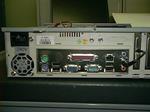
Learn to plan, facilitate installation and manage computer networks
A computer network, commonly just called a network, is a system of interconnected computers (and devices) that operate interactively. Any number of computers may be connected into a network, from two to dozens, hundreds, thousands or even millions. Networks typically include other devices such as printers, external hard drives, modems and routers, etc. The network provides communications between the devices so that they may share data, software, hardware and resources.
PHYSICAL TOPOLOGIES
Star
The computers in a star topology network are connected to a centralised hub or switch, and communications between the computers flows through the hub or switch. Different types of cables can be used in this topology, for example, coaxial, fibre optic or twisted pair cables.
Bus
The client computers in a bus network are connected by a shared line, called a bus. This conceptual architecture is also used on motherboards of computers, and in some versions of Ethernet networks.
Mesh
A fully or completely connected network is a mesh topology. In this type of configuration, every workstation or device on the network is connected to all others in the network. Mesh topologies are very expensive to implement, as there are large overhead costs with an excessive need for cabling. Also, these networks are difficult to maintain and expand.